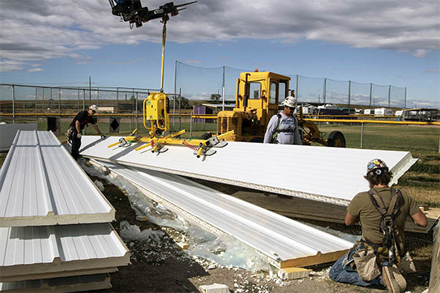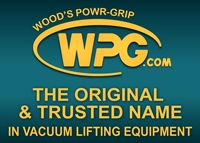Vacuum Sealed - An Overview Of Suction Cup Lifters For Insulated Metal Panels
By Dan Page, Woods Powr-Grip
Laurel, MT - Insulated metal panels (IMPs) can be challenging to lift, move, and install on the jobsite. Before vacuum lifting changed the game, the weight and size of IMPs required extra time, extra muscle, and extra equipment. More importantly, other
handling methods posed a greater risk for personal injury and load damage.
Flipping Roof Panels
 Bundles of roofing IMPs typically arrive from a manufacturer with every other panel inverted. They are shipped this way for cost savings. However, a panel
must be positioned “face up” to prepare it for lifting to a rooftop. Since roofing IMPs can weigh upwards of 227 kg (500 lbs.), manually flipping a single panel is a job that takes four individuals to complete. Typically, using a vacuum
lifter will reduce the number of workers needed.
Bundles of roofing IMPs typically arrive from a manufacturer with every other panel inverted. They are shipped this way for cost savings. However, a panel
must be positioned “face up” to prepare it for lifting to a rooftop. Since roofing IMPs can weigh upwards of 227 kg (500 lbs.), manually flipping a single panel is a job that takes four individuals to complete. Typically, using a vacuum
lifter will reduce the number of workers needed.
The vacuum lifter tilts the load so the panel rests on its female edge, just temporarily, before laying it down with the panel face up on a newly formed stack of panels. This method frees up crew members to work on other tasks, saving time and money.
It also significantly reduces the risk of injury to workers or damage to a panel.
Installing Roof Panels
There are numerous benefits of using vacuum lifters to install standing-seam or high-rib roof panels.
As with flipping roof panels, fewer workers are required for installation. By slightly adjusting the lifter’s position on the load, it is easy to match the correct pitch for installation. During placement, a standing-seam panel can be locked into
one that is already installed, without adjusting the pitch, just by using the lifter’s tilt function. Best of all, there are no slings to remove prior to landing a panel. More crew members (and more physical effort from them) are needed—not
only to remove slings, but also to hold a panel in the correct position before it is landed.
For installation of longer roof panels, some vacuum lifters are available with extensions to allow more pads (or a greater distance between pads) to attach at more points between one end of the panel and the other. This reduces the amount of overhang
and puts less stress on the panel.
Installing Wall Panels
 If a vacuum lifter is not used for installing wall panels, crews commonly use a wall clamp. To accommodate a clamp’s bolts, holes must be drilled
directly into a panel, which increases the risk of delamination or other damage. For instance, slightly mislocated holes might be visible on a panel after its installation, requiring additional correction or scrapping the entire panel altogether.
Oftentimes, these clamps are not commercially built and have no quality standards associated with them.
If a vacuum lifter is not used for installing wall panels, crews commonly use a wall clamp. To accommodate a clamp’s bolts, holes must be drilled
directly into a panel, which increases the risk of delamination or other damage. For instance, slightly mislocated holes might be visible on a panel after its installation, requiring additional correction or scrapping the entire panel altogether.
Oftentimes, these clamps are not commercially built and have no quality standards associated with them.
When a vacuum lifter is used, the panel remains unmodified. For vertical wall panels, a lifter’s vacuum pads are attached above the center of the panel for automatic tilting and greater stability of the load when lifted. For horizontal wall panels,
pad placement is on the center of the panel or just slightly above it, as the profile allows.
Depending on a lifter’s make and model, it can be adjusted to change the hang angle to match the installation angle for easier and faster installation.
IMP-Specific Variables
Several variables must be considered when selecting a vacuum lifter for handling IMPs or other cladding materials. These include panel weight, length, profile, surface texture, the type of metal skins, the core material, thickness, and material overhang,
as well as how the installer wants the panels to be maneuvered.
An IMP’s core material, thickness, and angle of handling are factors in determining the allowable material overhang. When using a vacuum lifter, consult the panel manufacturer to determine the necessary support while handling and, as available,
test a sample panel to ensure structural integrity is maintained with the resulting overhang.
The panel profile and weight must be considered when selecting the appropriate type of vacuum pads to attach. For profiles that have taller or deeper features, the pads’ sealing edges must be softer and taller to accommodate the increased displacement.
The more pronounced the features are, the more difficult it is to attach the pads. If this is the case, try using the weight of the vacuum lifter to assist. Panel weight usually dictates how many pads are needed to lift safely.
A panel’s surface texture plays a large part in selecting pads, too. Generally, surfaces with mild texture, like those that are stucco embossed, are readily accommodated by pads designed for the cladding industry. However, pad attachment to panel
surfaces that are “rough,” such as simulated stone, is more difficult. In such cases, panels and/or pads can be damaged, and pads can discolor the rough surface, too. It is always good practice to test the security of vacuum pads on rough-surface
panels and make sure the pads will not leave marks.
When handling wall panels with aggressive profiles or sensitive surfaces, some lifter operators prefer to handle panels from the back side. This method requires a little more planning for the lift, and installation proceeds a bit more slowly. Typically,
the lifter is positioned between the panel and the building as the lifter nears its installation point. Next, the bottom of the panel is set down at the installation point, to anchor it, while crew members manually maintain the upper position of the
panel using control lines or other means. Then the pads are released from the panel and the lifter is moved away. The pads are then released from the panel and the lifter is moved away. Finally, crew members continue moving the panel into its final
position on the building.
Indirect Loading
Dynamic loading and other inadvertent loading can negatively affect a vacuum lifter’s load capacity. Following are a couple of examples:
• Weight amplification that results when a loaded lifter abruptly starts or stops moving, changes direction, or bounces up and down, such as a when a loaded lifter is moved by a telehandler across bumpy terrain
• External force that effectively increases the weight of a lifter’s attached load, such as a panel reacting to wind gusts
Indirect loading should be accounted for whenever any material is handled using a vacuum lifter. This is especially true when handling IMPs, because of their generally large dimensions and weight.
Much More To Learn
Of course, there is much more to consider and learn about using—or not using—vacuum lifters for IMP handling. For instance, there are situations in which a vacuum lifter should not be used for any kind of material handling, such as use in
excessively hot/cold temperatures or in wet/windy conditions.
Generally, vacuum lifting equipment is intended for use only by experienced installers, and reading and following a vacuum lifter’s instructions is a must before ever using the equipment.
The greatest benefits provided by vacuum lifters are enhanced safety, a smaller labor force, and faster installations. Installers will still need to use control lines in nearly all IMP-lifting circumstances, but high-quality lifters include a host of
built-in safety features that give installers more control and peace of mind.
Ultimately, the right vacuum lifter can make installing IMPs safer and more efficient. It is worth the time to consult with a lifter manufacturer about which types of lifters would be most suitable for an IMP application.
No Singles Allowed
Do not use a vacuum lifter to lift single sheets or skins because…
• Overhanging material can buckle or fold when handled
• A lifter’s vacuum cups could distort the material when attached
Learn more about best practices for insulated metal panel (IMP) installation from the IMP Alliance, at MetalConstruction.org.
About the author: Dan Page has worked at Wood’s Powr-Grip for more than five years as a writer, editor, and designer of instruction booklets intended for end users of the company’s materials-handling products, as well as service manuals. He also writes marketing copy and assists in producing video content for wpg.com. Page joined the company after a lengthy newspaper career that included positions at the Montana Standard, Idaho State Journal, and Billings Gazette.
About Wood's Powr-Grip
 Wood's Powr-Grip Inc. designs, manufactures and distributes tools and equipment that improve efficiency, enhance
safety, and lower costs for the industries that it serves. The company offers a full line of hand-held vacuum cups, below-the-hook vacuum lifters and vacuum mounting cups that make material handling and equipment mounting easier. The products are
used to lift, hold and position a variety of smooth, nonporous materials such as insulated metal panels, glass, plastics, engine valves, sheet metal, solid surfacing, laminates, stone slabs and appliances. Powr-Grip products are individually tested
before being shipped from the production facility, in order to ensure quality and promote safety for the user.
Wood's Powr-Grip Inc. designs, manufactures and distributes tools and equipment that improve efficiency, enhance
safety, and lower costs for the industries that it serves. The company offers a full line of hand-held vacuum cups, below-the-hook vacuum lifters and vacuum mounting cups that make material handling and equipment mounting easier. The products are
used to lift, hold and position a variety of smooth, nonporous materials such as insulated metal panels, glass, plastics, engine valves, sheet metal, solid surfacing, laminates, stone slabs and appliances. Powr-Grip products are individually tested
before being shipped from the production facility, in order to ensure quality and promote safety for the user.
Wood's Powr-Grip's headquarters are located in Laurel, MT, and its vacuum cups and equipment products are distributed internationally in nearly 50 countries through an extensive network of dealers and distributors. For more information, visit www.wpg.com.




